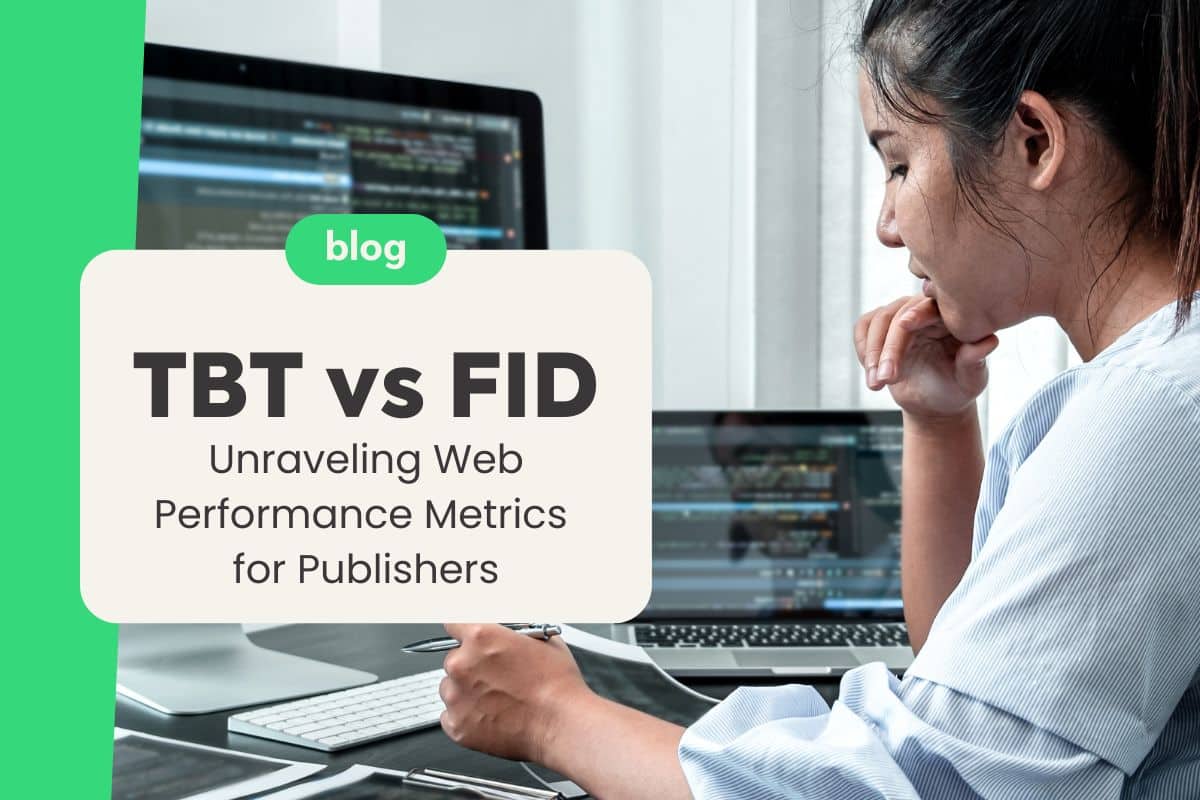TBT vs FID is a fundamental topic for medium and large publishers seeking a Google MCM partner or looking for new ad formats. Understanding these metrics is crucial for optimizing user experience and maximizing the monetization of your sites and applications. In this article, we will explore the differences between TBT and FID, how they impact your site’s performance, and provide valuable insights to help improve these metrics.
Index
What is TBT?
TBT (Total Blocking Time) is a web performance metric that measures the total time during which the browser’s main thread is blocked, preventing responses to user interactions. This often occurs during page content loading, when the browser is busy executing scripts or other tasks that block user interaction.
Importance of TBT
A high TBT can indicate that your site is taking too long to respond to user interactions, resulting in a negative experience. For publishers, this can mean a higher bounce rate and lower engagement, directly impacting ad revenue.
What is FID?
FID (First Input Delay) measures the time it takes from when a user first interacts with the page (such as clicking a link or button) until the browser responds to that interaction. This metric is crucial for understanding the user’s first impression when interacting with your site.
Importance of FID
A low FID is vital for ensuring a smooth and responsive user experience. This not only improves user satisfaction but can also positively influence Google’s search rankings, as user experience is an important factor in SEO.
TBT vs FID: Comparing the Metrics
While TBT and FID are important page performance indicators, they measure different aspects of user experience:
- TBT focuses on the total time the main thread is blocked during page load.
- FID focuses on how quickly the page responds to the user’s first interaction.
Crucial Differences
- Focus: TBT centers on main thread performance, while FID centers on user perception.
- Measurement: Both are measured in milliseconds (ms), but address different performance aspects.
- Impact: TBT indicates potential performance bottlenecks, while FID indicates the user’s perception of lag or unresponsiveness.
- Usage: TBT is useful for developers to optimize code and page architecture, while FID is useful for UX designers to understand how users perceive interactivity.
TBT vs FID: Understanding the Relationship
Although they are distinct metrics, TBT and FID are closely related. A high TBT can lead to a high FID, as a blocked main thread prevents the browser from responding to user inputs.
Improving TBT and FID
For publishers looking to optimize user experience and consequently increase ad revenue, improving both TBT and FID is crucial. Here are some strategies:
Improving TBT
- Split Long Tasks: Break up long scripts into smaller tasks so the browser has more opportunities to respond to user interactions.
- Use Web Workers: Move intensive processing operations to web workers, freeing the main thread to handle user interactions.
- Optimize Scripts: Minimize and compress your scripts to reduce execution and blocking time.
Improving FID
- Reduce JavaScript: Minimize the volume of JavaScript loaded initially, as large amounts can delay the browser’s response to user interaction.
- Disable Non-Essential Resources: Turn off plugins and widgets that are not essential for the user’s initial interaction.
- Defer Non-Critical JavaScript Execution: Use the defer or async attribute to delay the execution of scripts that are not critical to the initial rendering of the page.
How These Metrics Can Affect Performance
Example 1: Reducing TBT
A news publisher implemented task splitting and script optimization. As a result, they reduced TBT by 35%, significantly improving user experience and engagement rates.
Example 2: Improving FID
An e-commerce site applied techniques to defer non-critical scripts and reduced the initially loaded JavaScript. This resulted in a 50% reduction in FID, leading to increased conversions and sales.
Additional Resources
To deepen your knowledge and implement these improvements, check out the following resources:
- Google Web Dev: Total Blocking Time (TBT)
- Google Web Dev: First Input Delay (FID)
- Web Vitals: Essential Metrics for a Healthy Site
Conclusion
Understanding and optimizing TBT and FID is essential for publishers who want to maximize monetization and provide an excellent user experience. Grumft, a specialist in site and app monetization, is here to help you implement these improvements. Contact us to discover how our solutions can enhance the efficiency of your ad campaigns without compromising user experience.
Trust Grumft, as we have the expertise you need to transform the monetization of your site or application.





